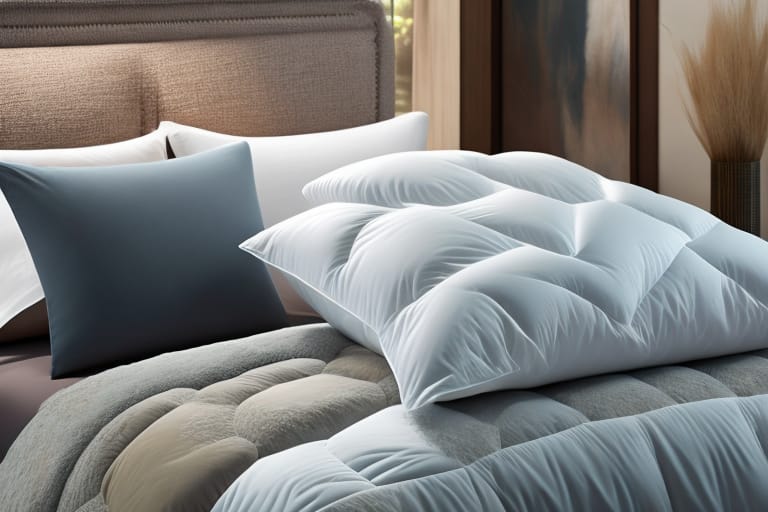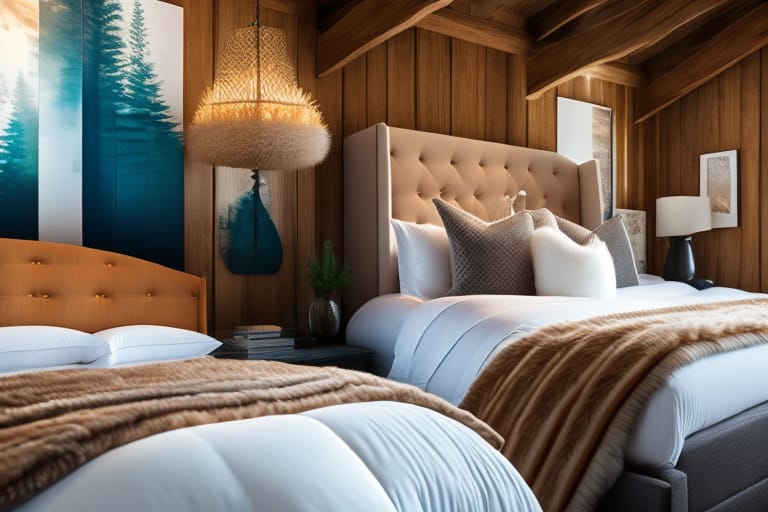When shopping for a down comforter, one common question that arises is “Do down comforters have feathers?” The short answer is sometimes. However, the full story behind down cluster and feather fill materials is more complex. This beginner’s guide will cover everything you need to know about the types of fills used in down comforters, the role feathers play, and what to look for when choosing bedding.
What Is Down?
Down refers to the underlayer of fine, fluffy filaments found under birds’ tougher exterior feathers. Waterfowl like ducks and geese are the primary source of down used in bedding. Down clusters are light, soft groupings of thousands of individual filaments that function to trap air.
True down clusters contain no hard central quills or stems. They demonstrate impressive loft – the ability to “fluff up” – which creates insulation. Higher fill power numbers (explained more below) indicate better loft and warmth.
Down offers unmatched softness and plushness compared to synthetic fills. Its impressive warmth-to-weight ratio also makes it highly efficient at trapping body heat.
However, while cozy and lightweight, down on its own lacks structure. So most down comforters also contain some feathers to add durability.
Feather Composition in Down Comforters
Not all down comforters contain feathers, but many do. Feathers differ from down clusters by having a central quill or stem. Barbs with smaller filaments branch off the quill.
Waterfowl feathers have a central quill and smaller branching filaments
There are two types of feathers typically used in down comforters:
- Duck feathers – Typically have a softer quill and more downy barbs. They add warmth and structure.
- Goose feathers – Quills are thicker and more durable. Better for reinforcement but not insulation.
While a percentage of feathers can improve the strength and loft of a down comforter, too many feathers reduces fluffiness. Down fills containing over 30% feathers are less common. High-end comforters generally have a higher percentage of fine down clusters and fewer feathers.
Advantages of a Down Comforter
| Down Comforters | Synthetic Comforters | |
|---|---|---|
| Durability | Lasts many years if cared for | Shorter lifespan of 5-8 years |
| Warmth | Excellent – one of the warmest insulators | Good |
| Softness | Extremely plush and cozy feel | Decent |
| Compressibility | Highly compactable when compressed | Bulky to store |
| Cost | $$$ – Higher upfront investment | $ – Very budget friendly |
Beyond impressive durability and insulation, down comforters offer unmatched softness and luxury feel. The finer and more numerous the down clusters inside a comforter, the fluffier and more comfortable it feels.
Higher fill power numbers (explained next) indicate more down and better loft. So when comparing options, fill power communicates warmth, feel, and quality.
Understanding Fill Power
Fill power represents the “fluffiness factor” – how many cubic inches one ounce of down takes up. For example, fill power 550 means one ounce occupies 550 cubic inches when fully lofted.
Higher fill powers signify:
- More down vs. feathers
- Larger, finer down clusters overall
- Better ability to trap insulating air
Most quality down comforters range from 600 to 800 fill power. Budget options are often 500-550 fill power. And luxury comforters go up to 900+ fill power.
When choosing fill power, balance warmth needs with budget. Higher numbers cost more but provide more insulation value per ounce.

The Role of Downproofing
One downside to extremely fine down clusters is they can poke through fabric over time. This results in little white down feathers escaping through the comforter shell.
To prevent leakage, down comforters feature special downproof fabrics tightly woven enough to contain feathers. Features like precise thread counts and stitching patterns also help.
Check the manufacturer’s information to understand their downproofing technology. High quality comforters invest seriously in down retention. This prevents frustration from cleaning up escaped feathers over time.
Ethical Sourcing Considerations
A vast majority of down comes from ducks and geese used in the food industry. However some questionable sourcing practices persist in parts of the world.
When shopping for down bedding, look for reputable brands that responsibly source materials. Certifications like the Responsible Down Standard audit supply chains for humane treatment.
Other Insulating Fills
For those seeking down warmth without animal products, down alternative comforters offer similar performance. Synthetics like microfiber mimic properties of down using polyester.
Down alternatives cost less and benefit those with allergies. However, they rarely match the cloud-like plushness of quality down comforters. And synthetics break down over time compared to the longevity of goose or duck down.
| Down Alternative Comforters | Down Comforters | |
|---|---|---|
| Durability | 5-8 years average life | Can last over 10+ years with care |
| Warmth | Very good | Excellent – best insulation lightweight |
| Softness | Good | Extremely plush and fluffy feel |
| Price | $$ – Mid-range | $$$ – More expensive upfront |
| Allergies | Hypoallergenic | Contains animal product |

Key Takeaways
- Down comforters provide unrivaled softness and efficient warmth from goose or duck under-plumage
- They contain down clusters – fluffy filaments lacking quill stems – along with some feathers for structure
- Fill power numbers indicate percentage of down vs. feathers and warmth ability
- Special downproofing techniques prevent fill leakage over time
- Down alternatives mimic down using synthetic fills as a hypoallergenic option
When choosing a down comforter, evaluate fill materials, fill power, and downproofing approach to find the right balance of quality, comfort, and value. Proper care also ensures longevity from this luxurious bedding investment.
Frequently Asked Questions
What percentage of down comforters have feathers?
Most quality down comforters contain less than 30% feather fill blended with fine down clusters. Higher percentages of feathers reduce softness and warmth. Premium comforters feature over 70% down comprising the fill.
How do I know a comforter offers good downproofing?
Check product details for the downproof fabrics or technologies used. Tight weave cottons like sateen along with precise reinforced stitching prevent fill leakage. Also look for high thread counts (600-900 tc) as indication of downproof quality construction.
What fill power rating is warmest in a down comforter?
Higher numbers equal more warmth from less fill. But fill powers over 700 fp often have diminishing returns for their premium prices. Most consumers recommend comforters between 600-650 fp to maximize value. Quality 700+ fp comforters cost over $500+.
Can you wash down comforters at home?
Yes, with some care! Use a large capacity machine, delicate cycle and mild detergent. Never use bleach. Dry thoroughly on low heat, re-fluffing every 20 minutes until fully dry to prevent down cluster clumping. Some drier balls can help too!
Why are goose down comforters more expensive than duck?
Goose down clusters tend to be larger and have more loft per ounce than duck. So they offer more warmth with less overall fill weight. Less fill = higher production costs, so goose down commands a premium. But well-made duck down comforters provide excellent performance too.
Are down alternatives as warm as real down comforters?
The latest generation of microfiber down alternatives come close to approximating down’s unmatched insulation. But no synthetics fully replicate the cloud-like floaty feel and longevity of premium waterfowl down fills. So down still leads for warmth, while down alternatives win for affordability.








